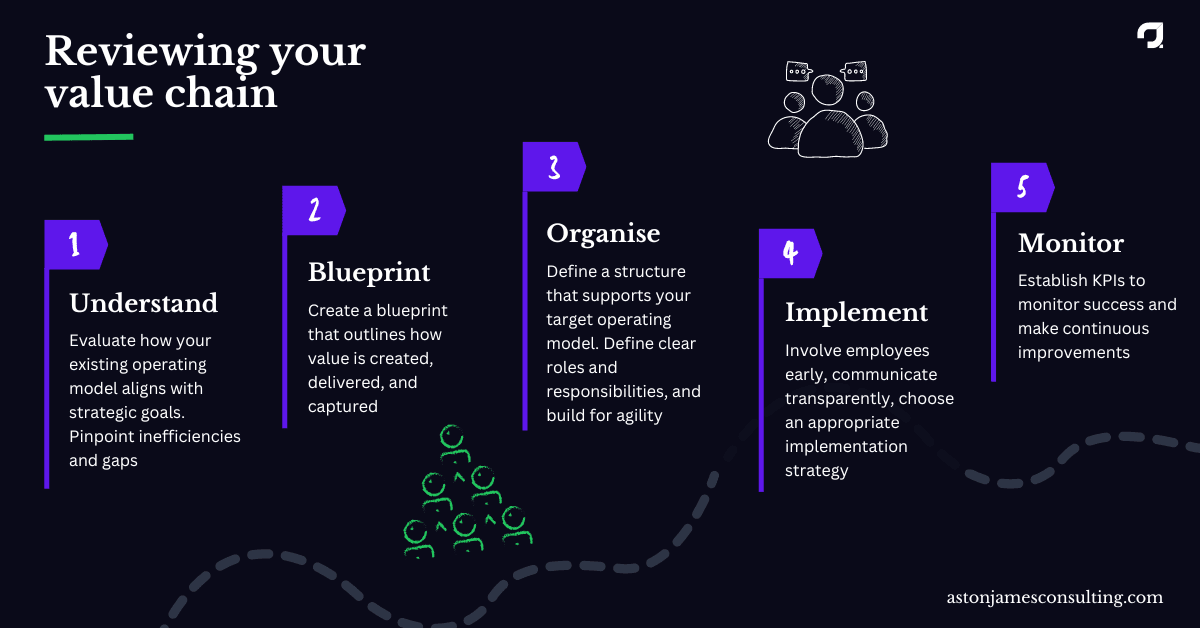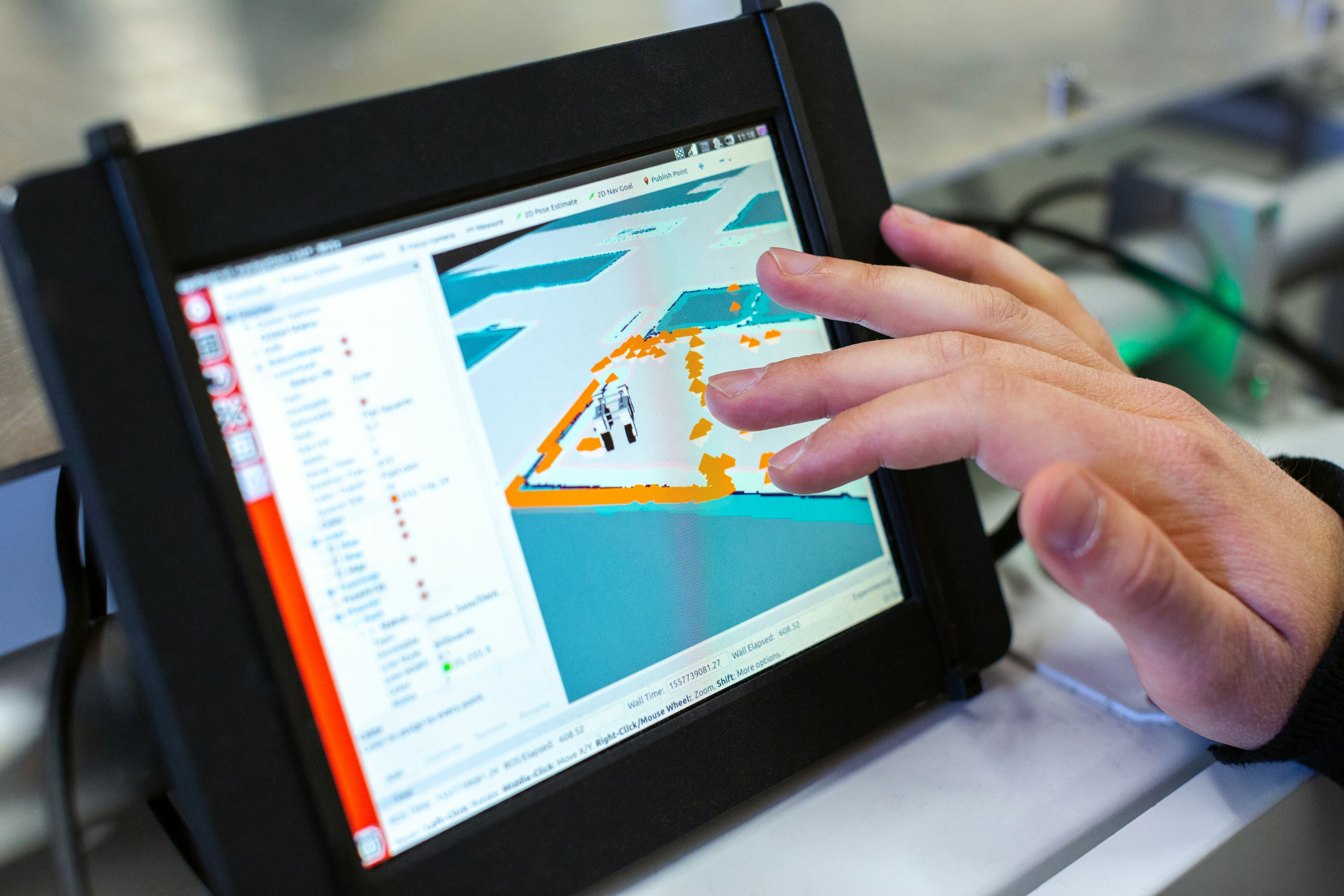Creating a new operating model and organisational structure
4-Minute Read

In brief
Evaluate how your existing operating model aligns with strategic goals, identify external and internal factors affecting your business, and pinpoint inefficiencies and gaps
Create a blueprint that outlines how value is created, delivered, and captured, ensuring it aligns with your business strategy, leverages technology effectively, and is adaptable for future growth
Select a structure that supports your new operating model, define clear roles and responsibilities, and build for agility to promote collaboration and responsiveness
Involve employees early, communicate transparently, choose an appropriate implementation strategy, and establish KPIs to monitor success and make continuous improvements

Understanding the current state
Before diving into the design of a new operating model, it's important to take a step back and assess your current situation.
Business Goals and Objectives Start by evaluating how well your current operating model aligns with your company’s strategic goals. Are your current processes and structures enabling you to achieve these goals, or are they holding you back? Identify the gaps and limitations in your existing setup to understand where changes are necessary.
Evaluating the External Environment Next, consider the external factors that impact your business. Market trends, competitive dynamics, and regulatory requirements should all inform your decisions. Additionally, assess how technological advancements are reshaping your industry. This understanding will ensure your new model is not only relevant today but also adaptable for the future.
Internal Analysis Evaluate your current processes, capabilities, and organisational culture. How engaged are your employees? Are there inefficiencies in your workflows? Understanding these factors will help you identify areas where your new model can add value and improve performance.
Defining your target state
Once you've assessed your current state, it's time to define your target operating model.
Core Components of an Operating Model An operating model is the blueprint for how your organisation delivers value to customers. It includes the key activities, processes, and resources needed to achieve this. Your operating model should clearly define how value is created, delivered, and captured within your business.
Aligning with Business Strategy Your new operating model must be closely aligned with your long-term business strategy. Consider how the model supports your strategic objectives and whether it is flexible enough to scale as your business grows. The goal is to design a model that not only meets today’s needs but is also resilient enough to handle future challenges.
Technology and Data Considerations In the digital age, technology plays a critical role in operational efficiency. Leverage technology to streamline processes, reduce costs, and improve customer experiences. Additionally, a data-driven approach will enable better decision-making, allowing you to optimise your operations continuously.
Designing the Organisational Structure
With a clear operating model in mind, you can now design an organisational structure that supports it.
Choosing the Right Structure Selecting the right organisational structure is crucial. Whether you opt for a functional, divisional, matrix, or flat structure depends on your business needs and market dynamics. Each structure has its pros and cons, so choose one that best aligns with your operational model and strategic goals.
Defining Roles and Responsibilities Clear roles and responsibilities are essential for avoiding overlap and inefficiencies. Define who is responsible for what, and establish clear lines of accountability and decision-making authority. This clarity will improve efficiency and help your organization operate more smoothly.
Building for Agility In today's fast-moving market, agility is key. Design your structure to promote agility by creating cross-functional teams that can collaborate effectively. Encourage a culture of innovation where employees feel empowered to experiment and adapt to changes quickly.
Cultural Alignment
Organisational changes can significantly impact company culture, so it’s important to manage this carefully.
Cultural Impact of Structural Changes Structural changes can be disruptive, so it’s important to manage the cultural impact carefully. Ensure that your new structure aligns with your organizational culture. If necessary, take steps to evolve your culture in tandem with structural changes to maintain employee morale and engagement.
Employee Engagement and Communication Involving employees in the change process is crucial for ensuring buy-in. Transparent communication throughout the process will help to manage expectations and reduce resistance to change. Engage your employees early and often to build a sense of ownership and commitment to the new structure.
Implementation Strategy
A well-designed model and structure are only effective if implemented correctly.
Phased Implementation vs. Big Bang When it comes to implementation, you can either opt for a phased approach or a comprehensive rollout. A phased approach allows for gradual adjustments and reduces the risk of disruption, while a big bang approach can be faster and provide people with greater certainty and less stress about changes to their role. Evaluate the pros and cons of each method based on your organisation's readiness and the complexity of the changes.
When rolling out changes over time, be considerate of change fatigue.
Change Management Managing change effectively is key to a successful implementation. Prepare for resistance by involving key stakeholders early, providing training, and offering ongoing support. Addressing concerns proactively will help to minimize disruptions and keep the organization focused on the transition.
Monitoring and Feedback Loops Finally, establish KPIs to measure the success of your new operating model and structure. Regular monitoring and feedback loops will allow you to make continuous improvements and ensure the new model remains aligned with your strategic goals.
Common Pitfalls to Avoid Be aware of common pitfalls such as underestimating the cultural impact of change, failing to communicate effectively, or not aligning the new op-model or structure with the company’s strategic objectives. By learning from these mistakes, you can avoid similar challenges in your own implementation.
Summary
Creating a new operating model and organizational structure is a complex but crucial task for business leaders. By thoroughly assessing your current state, carefully defining your new model, and ensuring cultural alignment, you can design a structure that supports your strategic goals and drives long-term success. Remember, the key to success lies in effective implementation and ongoing adaptation.
If you're considering a restructuring or redesign and need expert guidance, our consulting services can help you navigate this process. Reach out to us to discuss how we can support your business transformation.
Our experience spans industries
Select your industryEmergency Services
Technology
Public Service
Healthcare
Education
 Emergency Services
Emergency ServicesBetter protect people and environment with stronger intel and added capability
Strengthen operational control to better protect people, property, and the environment. Transform how your organisation uses data, processes, and technology to prepare for and respond to emergencies.
Explore Technology
TechnologyOptimise your frontline, back-office, and customer operations with digital technology
Improve the experience, quality, and productivity of your operations. Access rapid design, engineering, and digital operating model design services.
Explore Public Service
Public ServiceDeliver more efficient, innovative, affordable services for people and our environment
Implement modern tools to achieve your policy objectives. Create concise and accessible strategies and optimise your service delivery.
Explore Healthcare
HealthcareStrengthen patient and community outcomes with innovative tools and ways of working
Transform health outcomes with ambitious and innovative change. Improve patient care, streamline operations, and ensure regulatory compliance.
Explore Education
EducationImprove educational outcomes for learners by enhancing your corporate functions
Empower your people to deliver educational excellence by transforming your organisation's tools, processes, and operating model.
ExploreExplore our services

User Experience Design
Create sleek and engaging user experiences that reflect your brand and business objectives.

Engineering
Develop high-quality, user-centric applications.

Solutions Architecture
Create robust, scalable, and efficient IT solutions that meet your business needs.

Enterprise Architecture
Take control of your digital infrastructure and drive innovation and efficiency with modern architecture.

Organisational Design
Create an agile, effective, and resilient organisation.

Performance and Evaluation
Continuously improve your business with robust monitoring and intervention systems.

Strategy Development
Achieve your corporate and social aspirations with evidence-based planning.

Change Management
Ensure smooth transitions and successful outcomes with expert change management services.

Business Case Development
Develop a compelling business case that supports your strategy.
